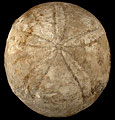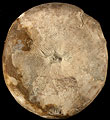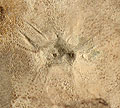Aplolampas has all the diagnostic characters of Echinolampas, with well developed, asymmetric petals, an inframarginal periproct on a relatively flat adoral surface that is slightly sunken towards the peristome, and feeble bourrelets. Aplolampas differs only slightly from the type species of Echinolampas in having a more rounded posterior margin, slightly more domed profile, and less developed phyllodes. Such slight variations in diagnostic characters are not worthy of generic distinction.
Lambert erected this genus for the specimens that Dames (1878, p. 42) referred to Echinolampas montevialensis. Lambert made a new species, Aplolampas lonigensis for these specimens of Dames\'s, as he believed they were not identical to Schauroth\'s species. Lambert then described this new species as the type species of Aplolampas. Kier (1962, p. 108) correctly points out that this action is invalid, as only the species referred to in the original description can be the type species.
Mortensen (1948, p. 311) reported that in Aplolampas the floscelle is very indistinct, the ambulacra forming no phyllodes. Although not well developed, phyllodes are present in the type species.
W. Dames. 1878. Die Echiniden der Vicentinischen und Veronesischen tertiarablagerungen. Palaeontographica, 25.
P. M. Kier. 1962. Revision of the cassiduloid echinoids. Smithsonian Miscellaneous Collections, 144 (3) 262 pp.
Lambert, J. 1906. Etude sur les echinides fossiles de la molasse de Vence. Annales de la Societe des Lettres des Sciences et Arts de Alpes-Maritimes 20, 64 pp., 10 pls.
J. Lambert & P. Thiery. 1909-1925. Essai de nomenclature raisonnee des echinides. Libraire Septime Ferriere, Chaumont, 607 pp., 15 pls.
T. Mortensen. 1948. A monograph of the Echinoidea: 4 (1): Holectypoida, Cassiduloida. Reitzel, Copenhagen, 363 pp., 14 pls.





